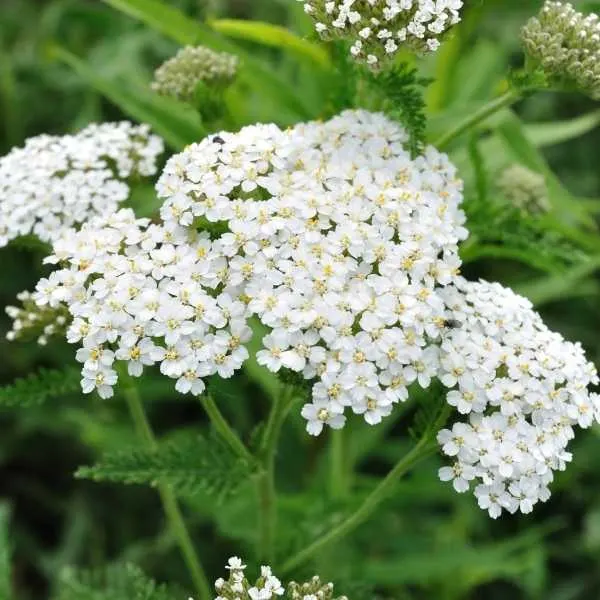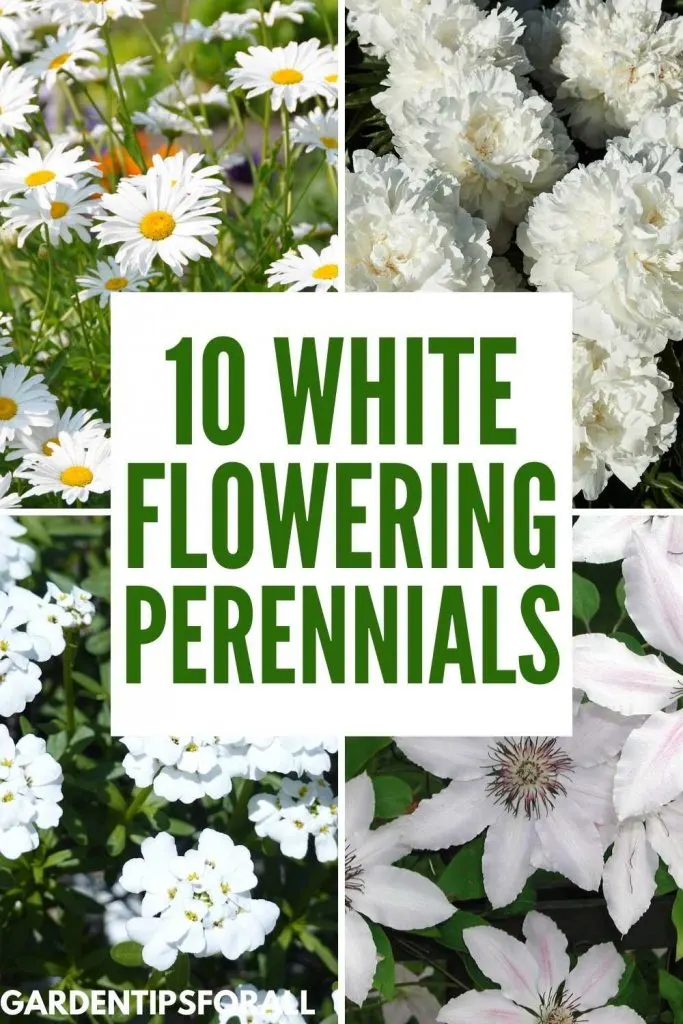White Flowering Perennials that Will Add a Touch of Glow to Your Garden or Yard
White flowers add a cool touch to your garden and practically glow in the dark, making them an excellent choice for borders or walkways.
Planting white perennial flowers along with your more colorful plants can add that little something special to your garden or border, adding more interest to your property.
Planting perennial flowers in your garden means that that flower will come back year after year saving you time and effort since you don’t have to plant new flowers every year.
For those of you interested in adding some white flowers to your garden here is a look at some of the more popular white flowering perennials.

Related Articles:
- 12 Attractive Yellow Perennial Flowers
- 10 Adorable Pink Flowering Perennials
- 15 Amazing Geranium Varieties
10 Awesome White Perennial Flowers
#1. White Achilea (Yarrow)

The Achilea flower is more often called Common Yarrow. This perennial plant can grow to be more than 3 feet tall and has feathery shaped leaves that have a lacy look and feel.
There is a cluster of mini flowers on the long slender stems. Common Yarrow comes in white and also in yellow, pink, red, purple and orange.
This flowering plant is native to Asia, Europe and North America and grows best in zones 3 through 9. It prefers full sunlight and well-drained soil.
Do keep in mind that Yarrow is toxic to dogs, cats and horses.
#2. White Azelea

There are several varieties of the flowering Azelea shrub. Although the flowers commonly come in your choice of pink or red, there are also white versions of this shrub.
White Azeleas come in both dwarf and taller varieties. While the average height of Azelea bushes are between 4 and 6 feet there are varieties that range between 1 and 20 feet.
Azeleas do best in hardiness zones 4 through 9 and they love partial sun and well-drained soil.
#3. Candytuft

Candytuft is a flowering woody shrub. This perennial plant has small leather-like green leaves with small white flowers with gold accents (these also have pink flowers) that bloom late spring to early summer.
These flowers grow from 12 to 18 inches tall. One notable thing about these flowers is that they have an unpleasant scent.
Native to Europe and the Mediterranean the Candytuft bush grows bests in hardiness zones 3 through 9. They love full or at least partial sunlight and well-drained soil.
#4. Clematis

The Clematis is a flowering vine that can grow anywhere from 3 to 10 feet tall (or long). The plant has pretty blue-green foliage and its flowers come in a variety of colors besides white including purple, pink, yellow and red.
The flowers of the Clematis bloom late spring throughout the summer and have a lovely light scent.
This vine grows best in zones 4 through 9 and prefers 6 hours of sunlight each day and cool soil. It’s very attractive to birds.
#5. White Hellebores

Hellebores are low maintenance perennial flowers that tend to bloom late in the winter or early spring. This plant is known for its thick foliage, palm-like lobed leaves and its flowers that resemble roses.
The flowers are white as well as purple, pink, or yellow. This flowering plant grows 1 to 2 feet tall.
Native to the Middle East, Hellebores grow best in zones 3 through 9 and like sunshine during the winter months, but prefer shade during the summer. They also prefer moist well-drained soil.
#6. Shasta Daisy

The Shasta daisy is a hybrid developed in the 19th century in North America. Originally, these flowers were white with yellow centers, but today these flowers come in a wide variety of colors.
Shasta Daisies can grow to be between 9 inches to 3 feet tall and blooms in the spring and summer.
This flowering plant grows best in zones 5 through 9 and does well in full or partial sunshine and moist well-drained soil. They are toxic to pets. (Here are other types of daisy flowers.)
#7. White Hydrangeas

The Hydrangea is a perennial ornamental deciduous shrub that comes in several varieties and colors. White hydrangeas look stunning against the bright green foliage.
What makes the flowers of this bush really stand out is that they are made up of a group of tightly clumped flowers that form a round flower ball.
This is a fast growing plant that can grow 2 to 4 feet per year and blooms mid-summer through fall.
Native to Asia and the Americas, this flowering bush grows best in zones 5 through 9. Hydrangeas love full or partial sun and do well in any type of soil as long as it drains well.
This plant is toxic to both humans and pets.
#8. White Liatris

The Liatris flower also known as “Blazing Star” is a long blooming perennial wildflower native to North America.
A member of the Aster family, the flower head has tiny star like blossoms arranged on a spire and grass like leaves. These flowers come in purple and reddish purple as well as white and bloom from summer to early fall.
Liatris grows best in zones 3 through 9 and enjoys full sunlight and moist well-drained soil.
#9. White Peonies

Peonies are lovely flowers that are known for their lush green foliage and flower heads that look like those tissue paper flowers most of us learned to make in school.
They come in several different colors besides white, including pink, yellow red and purple flowers that bloom during the spring and summer months.
Peonies grow best in zones 3 through 9 and prefer full sun and well-drained soil. They are mildly toxic to both humans and pets.
#10. Jasmine Gardenia

The Jasmine Gardenia is native to China and Japan. This flowering shrub has dark green spear shaped glossy green leaves and large showy rose-like double petals.
These flowers have an extremely fragrant scent that blooms from early spring through summer.
The Jasmine Gardenia grows best in zones 8 through 11 and prefers full sunshine or at least partial sun and moist well-drained soil.
These bushes grow between 3 and 6 feet tall and are toxic to dogs, cats and horses.
Final Thoughts on White Perennial Flowers
If you are looking for one or two varieties of white perennial flowers to add to your garden or yard, then one of the above mentioned flowering white perennials should meet your needs without any trouble at all.

